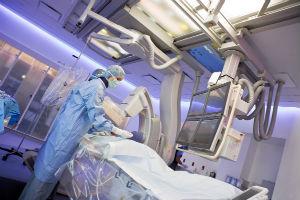 The Indoor Air Quality (CAI) in health centers depends on the correct planning that goes from the design stage to the products and methods that allow to achieve the primary objective of guaranteeing the best conditions for the correct functioning of the establishment.
The Indoor Air Quality (CAI) in health centers depends on the correct planning that goes from the design stage to the products and methods that allow to achieve the primary objective of guaranteeing the best conditions for the correct functioning of the establishment.
by Oscar Moreno*
Our vast experience in the development of management and maintenance tasks (both preventive and corrective) in hospitals and other health centers, allows us today to affirm without a doubt that the treatment and quality of indoor air in such institutions dedicated to the care of the health and well-being of our society demands exhaustive considerations in order to achieve specific and sufficient hygiene and comfort conditions to offer medical care. adequate.
From this perspective, air conditioning and ventilation are essential elements to safeguard the well-being of the users of these establishments, read patients, staff and visitors.
These reasons lead us to be in front of complex buildings, which require the intervention of disciplines outside the health sector to take charge of the aspects of cleanliness and safety, where people are most vulnerable, and whose design confronts us with a wide panorama of issues to be covered and not only those related to the planning of spaces and the aesthetics of the place, but those related to the user community and technological advances, which becomes necessary to consider if we want utility and effectiveness.
This topic is addressed by various norms and standards such as ASHRAE 170-2013 (Ventilation of Health Care Facilities and the ASHRAE HVAC Design Manual for Hospitals and Clinics-2013, aimed at ensuring quality in the building infrastructure, in this case the hospital, in issues such as pressurization, air injection, time renewals, mechanisms for the control of asepsis, artificial ventilation and air filtration systems.
Complying with these directives raises the prior need to properly classify the different areas of the health center, according to the critical level and risks of infection they offer for a subsequent and correct identification of the parameters and recommendations to be taken into account.
From the point of view that involves us, the movement and treatment of air is the heart of a hospital, where the non-existence of adequate barriers to contain pollutants both solid and gaseous and biological would cause all kinds of disorders and ailments.
It is, therefore, unobjectionable to show the important role that air filtration and treatment plays in all this; becoming a key complement in the prevention of hospital-acquired diseases. Of course, different sectors supplied will require different filtering efficiencies, in this sense the MERV rating (Minimum Reported Efficiency Value) takes into account this parameter along with the size of the solid contaminant particle to be removed.
No less significant is the task of achieving the level of clean air required for each application, as well as understanding the control and flow of that air to achieve the appropriate pressurization levels as the case may be.
Now, when choosing a filtration system for a health center many and varied circumstances must be considered, one of the most basic will be to define if the objective will be to protect the machinery that moves the air or protect the people of the building. Obviously the right answer will be both; in this, the types of filters to be used become vitally important.
While low and medium efficiency filters have been designed to protect machinery, keeping it clean, high efficiency filters become relevant to provide a healthy and safe environment.
Washable, disposable flat or pleated panel filters, with MERV range below 13, are generally low cost and low resistance to airflow but, of course, insufficient to achieve a valuable result when efficiency levels in air particulate retention need to be improved.
The high efficiency ones – above MERV 13 – historically always presented more resistance to the passage of air so, when it comes to having to improve the existing filtering system, it leads us to find, in most cases, that it is not possible to do it without previously making modifications to the equipment, modifications that not only compromise the fan unit but also the existing filter frames and structures.
Fortunately, the growth in the development of filter blankets and the design of filters make this no longer true. There is a new generation of high efficiency products that has a high performance in the capture of contaminants with very low levels of resistance to the passage of air, in the latter aspect they resemble medium efficiency filters.
In previous paragraphs, we have referred to the need to classify the different areas of a hospital; at this point we can not fail to mention the operating rooms, which frame as an area of high risk of infection. In them, the role played by the flow of air in terms of maintaining a sterile field is really critical, attentive to which they are seen in an interesting parallel with the so-called cleanrooms.
This is how another type of filters appear on the scene, the so-called HEPA (High Efficiency Particle Air) prepared to retain contaminants and particles much smaller than the other filters mentioned so far. The traditional constructive characteristics of a HEPA filter make them present a high resistance to the passage of air, this is where the new products generated by the air filtration industry appear creating new elements with the most sophisticated manufacturing technology.
From all the above, it clearly emerges how air filtration improves and can solve many of the indoor air quality problems in a health center, however by itself it is not a total panacea. Airborne microorganisms such as bacteria, viruses and fungal spores present a real challenge to hospital engineers and maintenance staff. The most important physical characteristic to classify them is their size, as it will directly impact the filtering efficiency.
Well, it happens that many of these microorganisms will cross each and every one of the filtering barriers, including that of HEPA filters, even the same coils of the ventilation, heating and air conditioning systems will become the ideal place for the cultivation and reproduction of those.
Throughout several years of our career, the lack of a technological response to this problem made us mere spectators of such a situation. Fortunately, not long ago, the appearance on the international market of a new system of ultraviolet emitters in C band with cutting-edge performance and optimal performance turned expectations and needs into facts and solutions.
It should be clarified that in all those applications that involve the disinfection of the air flow, the effectiveness of the UVC will depend on several factors, including air velocity, exposure time and the degree of resistance of microorganisms.
As well as the technological advances already manifested in air filtration, from this innovation introduced by SterilAire, Inc., the field of UVC already has high power emitters capable of being located even in key places such as the air conditioning equipment itself.
The implementation of this system in hospitals brings with it a number of notable benefits, such as the following:
- Reduction of acquired infections,
- Elimination of manual cleaning of coils,
- Increase in its useful life,
- Reduction of energy costs
- Removal of mold, bacteria and viruses from coil, airflow and drainage trays
All this shows that, in short, it will be a correct and planned combination of design, equipment, products and methods that will allow to achieve the best results in terms of indoor hospital air quality.
* Oscar Moreno is the president of Industrias Bellmor S.A, in Argentina, and can be contacted through the telephone number (054-11) 4544-0780 or by visiting the website www.bellmor.com.ar













